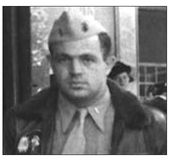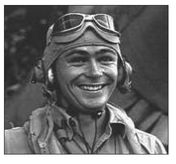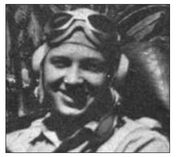War Stories II (41 page)
Authors: Oliver L. North


LIEUTENANT HENRY BOURGEOIS, USMC
Vella Lavella Island
21 September 1943
1500 Hours Local
Vella Lavella Island
21 September 1943
1500 Hours Local

I always wanted to be an aviator. And when a recruiting bunch came through, they got me. I'd already made up my mind I wanted to be a Marine.
I got to Guadalcanal in January 1943. I was assigned to VMF-122, flew two combat missions with them, and went with Boyington when he organized 214.
Since some of the other guys and I had combat experience, he selected eight of us as division leaders. The rest from the fighter pool would be new pilots. I flew my first mission with 214 out of the Russell Islands.
On this one mission, I remember the bombers were to go after the shipping in the harbor. And, they were probably at 9,000 or 10,000 feet.
We had sixteen Corsairs, closely covering the bombers, and above that some P-38s beyond sight, high up. We got up there, and saw that the whole harbor was covered with a thunderstorm.
And the bombers pushed over early because they had to get down below. By the time they pushed over, a whole sky full of Japanese airplanes appeared, going after everybody.
It quickly broke into an air-to-air dogfight. And, pretty soon, they're all over the sky. I had somebody shooting at me. I'd go into a cloud, mill around a little, come out, and shoot at a Japanese airplane, get shot at again, go into a cloud, and come out and still try to stick with the bombers if we could.
That was the typical type of gunfight. We lost two SBDs and two Corsairs that time. One of our SBD rear gunners claimed one Zero kill. And I think we claimed five or six.
So I decided to head back to base, and I'm not paying too much attention to what I'm doing. I'm just flying along at about 5,000 to 7,000 feet and see tracers coming by. I look in the rearview mirror, and there's
a Zero back there, shooting at me. So, I two-blocked the throttle, and headed downhill as fast as I could. But the Zero was sticking with me.
a Zero back there, shooting at me. So, I two-blocked the throttle, and headed downhill as fast as I could. But the Zero was sticking with me.
And this guy kept sneaking up and firing, sneaking up and firingâgetting closer. Then I discovered I was headed in the wrong direction and running low on fuel. So I'm going to have to turn and fight this guy.
I knew he was going out-turn me unless I did it first. I was just about ready to do that when he turned back to his base.
We did a lot of escort missions for B-24s, dive-bombers and torpedo bombers, and did a lot of strafing missions. Or we'd be protecting destroyers that had been hit, backing down a slot.
Pappy Boyington was thirty-one years old then, at least seven years older than the rest of us. Major Boyington, in the air as a pilot, was a superior leader.
If you talk about his accomplishments in the air as a flight leader, you can't fault him. He was excellent. In two combat tours, we lost eleven pilots out of a total of fifty-four. And Pappy Boyington asked Bailey, Case, Beggart, and me to stay for a fourth combat tour. I said, “Pappy, I think my time's running out. I'd better go back home.”

FIRST LIEUTENANT
JOHN F. “JACK” BOLT, USMC
Vella Lavella Island
28 September 1943
0730 Hours Local
JOHN F. “JACK” BOLT, USMC
Vella Lavella Island
28 September 1943
0730 Hours Local

From the beginning, we were facing pilots who had been in the Zero for several years. They probably had 500 or 600 flight hours. Our typical pilot in Joe Foss's squadron or my squadron would have had maybe 150 or 200 flight hours.
But we were finally getting experienced pilots who had been fighting the Zeros for three combat tours. Joe Foss was one of them. They were instructing us on the advantages and the disadvantages of fighting them.
Boyington had acquired a tremendous amount of knowledge in his experiences in China, far more than anybody else had. And he could rev up the guys to do the best they could. He was a scoundrel, and charming, but we had a real good esprit de corps by the time we went into combat.
I got my first kill on 16 September. It was my first escort mission to Bougainville. The Zeros were probably about 10,000 or 12,000 feet, and I'd come down from maybe twenty and gotten in behind them, trying to remain in their blind spot. I got two on that flight.
I got back at the base at Turtle Bay and went to the scrap heap for some parts of wrecked planes, and got a .50-caliber machine gun and shot different rounds into this debris. The common belting for our machine guns was one armor-piercing shell, one incendiary, and a tracer.
The armor-piercing shell was something you didn't need on the Zero. The Zero didn't have armor. And you just need tracers initially to see where your guns are hitting. The thing that would torch off the Zero was the incendiary. It would scatter phosphorous around the small area [inside the cockpit] so that it was almost solid phosphorous for maybe a foot in diameter where the incendiary went off.
So, I got Boyington out to the scrap heap and showed him what the rounds were capable of. After that we immediately went to a belting of a much larger number of incendiaries. And we got real good results from it, too. The Zeros were blowing up noticeably faster.
 MARINE FIGHTER SQUADRON VMF-214 READY TENT
MARINE FIGHTER SQUADRON VMF-214 READY TENTMUNDA POINT, NEW GEORGIA
17 OCTOBER 1943
0400 HOURS LOCAL
17 OCTOBER 1943
0400 HOURS LOCAL
Like the rest of the Allied air bases springing up on the Solomon Island chain and the others to the northwest, Munda Point, on the island of New Georgia, was a terrible place with a reputation as a “malarial hell-hole.”
Each night the Black Sheep Squadron had visitors who made life miserable for them. Their first night at Munda, the Japanese welcomed them with
a bombing raid at one o'clock in the morning. They kept up that routine, visiting the base up to three times a night, making it impossible for the pilots to get a full night's sleep.
a bombing raid at one o'clock in the morning. They kept up that routine, visiting the base up to three times a night, making it impossible for the pilots to get a full night's sleep.
When the air raid alarm went off, the men found cover, waited for the Japanese bombers to leave, then went back to bed, only to be awakened a few hours later with the same routine. By 0400 the pilots were roused againâbut on 17 October 1943 the last call wasn't the air raid alarm. It was the duty officer getting them to the flight line for another day's mission. This day, the Black Sheep Squadron was on another bombing run against the Japanese air base at Kahili.
Spurred on by his sense of competition, Major Boyington tried a new tactic with his pilots. Now, instead of waiting for Japanese aircraft to attack, he began flying over their bases and taunting them to respond. He even used his radio to let them know he was coming and told them that he was the guy who shot down all their planes. The tactic workedâthe enemy picked up the gauntlet and fought back with a vengeance. And as the Black Sheep moved ever closer to the Japanese stronghold of Rabaul, those fights over enemy airspace got increasingly hotter.
It's always riskier getting into a dogfight over an enemy's airspace. If your plane got hit and you had to bail out, there was a good chance you would survive if you were in your own airspace. But over enemy territory, the odds were in favor of your dying there. If you bailed, there was every chance that a Zero pilot would try to gun you down in your parachute. If you were lucky enough to survive the parachute drop, chances were that enemy soldiers on the ground would kill you when you landed.
Boyington had first challenged the Japanese to aerial battles when they were dogfighting over Bougainville. With its strong Japanese presence, sweeps over Bougainville were always high-risk.
Boyington continued to goad the enemy until he received a cable from Admiral Halsey. It read: YOUR STEEPLECHASE IS OVER. YOU ARE RETIRED TO STUD.
Actually, Halsey was saying that their first tour of air combat duty was over and he was granting the squadron some well-deserved R & R in Australia.
Two other members of the Black Sheep Squadron who went with Boyington to Australia were just twenty-two when they landed in the South Pacific.

LIEUTENANT ED HARPER, USMC
Vella Lavella Island
29 October 1943
1100 Hours Local
Vella Lavella Island
29 October 1943
1100 Hours Local

The first time I saw an F4U Corsair was on an air station before I went overseas, before I got to the South Pacific. Espiritu Santo is the first time I saw one up close. At Espiritu Santo we got assigned to 214 as part of the replacement pool.
I wasn't even aware who Boyington was for the first few days. We only knew he'd been in the Flying Tigers when we started training as a squadron.
Initially I was very aggressive, and had no fear at all, until suddenly I was on the receiving end instead of the delivering end. And that's very sobering. It never got easier, when you were on the receiving end. Zeros were hard to shoot down. I fired a whole load of ammunition into one, almost point-blank, as he dove away. And he barely burned. But he obviously was done for. He was no longer fighting and was crashing into the sea. But he didn't blow up for me. In fact, he didn't burn easily at all.
Zeros were flown by very skilled pilots and were hard to shoot down. Most Zeros that were shot down were targeted by pilots that didn't let the Zeros see them coming.
I got hit a couple of times with Zeros that I never saw, too. And that was pretty typical. I was just a kid trying to do some good. I only got one confirmed, and a couple of probables, and a few more I just shot up.
The intelligence officer took your word for it. If I'd have been inclined to exaggerate, I could've been an ace. I really shot that guy down that went
in the ocean and I shot up a couple more until they were riddled with holes, but I didn't see them burn or crash. So you didn't count them.
in the ocean and I shot up a couple more until they were riddled with holes, but I didn't see them burn or crash. So you didn't count them.
Boyington gave me the nickname “the sleeve” after I got shot up the first time. A “sleeve” is the target sleeve that's towed behind another plane to offer fighters gunnery practice.
It was my first tour and I hadn't shot down anything. Other guys were having a little luck. But I was trailing and I was getting anxious.
I got off by myself and found a Zero down below me. I started making runs on him. That's when I discovered how maneuverable they were. Every time I got close to him, he'd do a split S underneath me. I'd do a wing over, and come back. And he'd do another split S. We were working ourselves down over the harbor, right off the end of their runway. And my thought was, that little bugger can't split S forever. He'll do a split S into the ocean. But what I didn't realize, all the way down, he must have been hollering for help on his radio.
Suddenly I had a lot of extra company. And instead of being on the offense, I suddenly was on the defense, trying to stay alive. There was a small cumulus cloud, a mile or so away. I jinked left and right, and up and down, and I finally made it into the clouds. And of course you felt like you were playing tag. I popped in and out, ended up getting some pretty good shots at several Zeros.
After playing that game for a while, I dove out the bottom of the cloud and headed home. Nothing fatal was hitâthe engine wasn't hit. I wasn't hit. The landing gear wouldn't come down so I had to make a belly landing. But, otherwise it was a non-event.
It didn't seem to be a big deal, except I had over a hundred holes in my airplane when I got back. Boyington took a look at the airplane and said, “You were a target sleeve today.”
We had no idea we were setting records. And we were having reasonable success. But we didn't expect the attention that we received along the way. You didn't want to think about it.
3 January 1944, Boyington was shot down. We were coming out of Bougainville, and when he didn't come home, we asked to go on a search
party. And they wouldn't let us. The following morning, they let four of us take off and go look for him, providing we got back in time for our regular mission. If the Japanese sub hadn't come along and picked him up early that morning, we would've found him.
party. And they wouldn't let us. The following morning, they let four of us take off and go look for him, providing we got back in time for our regular mission. If the Japanese sub hadn't come along and picked him up early that morning, we would've found him.
I said then, and I still say sixty years later, Pappy made me feel secure. He made me feel aggressive. He gave me confidence. He was a leader. Sure, he got in trouble on the ground from time to time, and liked to drink and fight. But he was terrific in the air. And he made us young fighter pilots brave. And that's leadership.
Other books
The Commitment by Kate Benson
Melindas Wolves by GW/Taliesin Publishing
The Returners by Malley, Gemma
The Contemporary Buttercream Bible by Valeriano, Valeri, Ong, Christina
La página rasgada by Nieves Hidalgo
Resistance (Ilyon Chronicles Book 1) by Jaye L. Knight
A Dog and a Diamond by Rachael Johns
Fenway Fever by John Ritter
Back Before Dark by Tim Shoemaker
